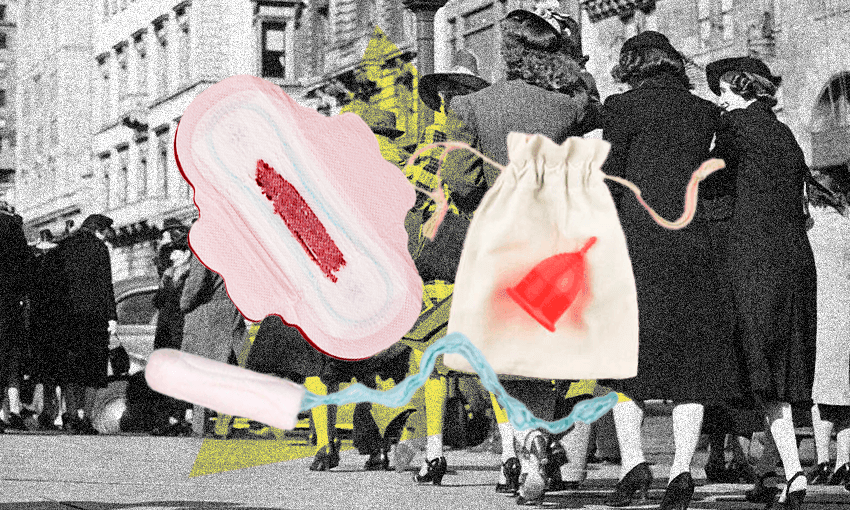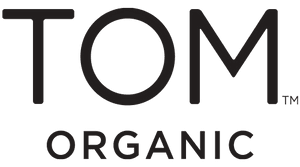There are so many options for menstrual care products available on the supermarket shelves these days, but that wasn’t always the case. Alex Casey spoke to five people from different generations about what period care was like for them.
We’ve come a long way when it comes to attitudes to periods in Aotearoa. You’ll see menstruation popping up in our local comedies, or dystopian dramas, our reality TV shows, just as readily as you’ll read headlines announcing free period products in schools, or people speaking up about the challenges of menopause and endometriosis.
Walking through the aisles of the supermarket, you’ll also see so many more options available to those who have a period every month. Where once there were only pads and tampons on the shelves, these days menstrual cups are mainstream and reusable period undies, washable liners and pads offer even more solutions for those worried about creating period waste.
In an attempt to trace the true evolution of period product use and our changing attitudes towards menstruation in Aotearoa, I interviewed people across four vastly different generations – the oldest being 83, the youngest 14 – about having their first period and how the range and availability of period products has changed.
Born in 1942: ‘My mother brought out the belt, the safety pins and the towels’
Coming of age in Auckland in the mid 1950s, Anne remembers “everybody was very embarrassed about the whole affair” that was menstruation. She was a shy teenager at a co-ed school in Ellerslie and, although they got “the basic facts” in health class every year, nobody asked questions, the girls didn’t talk about periods with each other and certainly not near the boys.
It was at home where she got the period crash course. “When I was about the equivalent of year nine, my mother brought out the belt and the safety pins and the towels,” she explains. “You had to use little hand towels and pin them on (the belt) and then wear navy blue bloomers over that.” When the towels had done their dash, they were collected in the laundry tub and hand washed.
Anne recalls the towels being very “bulky and smelly” and extremely inadequate for her heavy flow. But choices were severely limited. There were only two places in her area that sold disposable sanitary pads – a chemist full of men and a posh ladieswear store. “The very first sanitary pads were dreadful anyway, they were cheesecloth with cotton wool inside, and would form these little balls that would stick to you.”
As a teenager she was aware that her mother used something called Tampax, and built up the courage to ask her about it. “She said ‘oh no, no they’re not for you, they are for when you are a grown up lady,” Anne laughs, referring to the myth of the time that using a tampon would mean you are no longer a virgin. It wouldn’t be until many years later – when she was in her 20s – that she would start using tampons herself, a much more convenient option by comparison to the rudimentary sanitary towels of her high school days.
Seventy years since her first period, Anne says much has changed in New Zealand around menstruation. Having free period products in schools would have once been unheard of, and she’s noticed reusable period underwear now being widely available – a far cry from the towels and belts of her youth. “I saw some at the supermarket just this morning,” she says. “It’s such a good idea because those products do cost.”
To prove just how much has changed since her period heyday, Anne recently was talking to her granddaughter, a recent university graduate, about what period products are popular. “I said to her ‘are any of the girls still wearing belts?’” chuckles Anne. “She just giggled.”
Born in 1961: ‘The sanitary pads were as big as surfboards’
As Michele was hitting puberty in the mid 1970s, she remembers the conversation becoming much more open about sex and periods. “Everybody was giving their children copies of ‘Where Did I Come From?, which is a book about sex and conception,” she recalls. “There was definitely a sense of that liberation from conservatism and secrecy around it all.”
During their intermediate health class, separated by gender, Michele remembers seeing an image of a uterus, shaped like a bulls head, on an overhead projector. “I came away with a very clear idea that every month, your uterus would be lined with blood,” she recalls. The girls came out of the class chatty and giggly – the boys looked like “they had just seen a horror movie”.
She was 15 when she got her first period, during a visit to Hawke’s Bay with her mother, grandmother and great aunt. “Suddenly all those women just gathered me up in the kitchen and told me all their period horror stories because we’re a family of heavy bleeders,” says Michele. “It was hilarious and fun. I was just so delighted to finally feel like one of them.”
While her family might have had a more liberal approach to periods, the products available were still very limited. Michele used sanitary pads which were “as big as surfboards”, secured into a large pair of cloying plastic-lined briefs. “No wonder we all had thrush,” she laughs. “They were supposed to stop flooding but of course it didn’t work for me.”
At school, used pads were seen as dirty secrets – they would be disposed of behind a mysterious metal door, and then carted off to a nearby incinerator by the caretaker. “Every now and again there would be ash in the air and you’d be like ‘ooh, they are burning the pads’.”
Fifty years on from those ash laden sanitary pad skies, Michele says the conversation has “completely changed” around periods and that the range of products is liberating for people with periods. “I think it is fantastic that there are so many choices,” she says. “It used to be an act of rebellion to say that you had your period, and I think the rebellious thing to talk about now is menopause.”
Born in 1985: ‘this was also the era of applicator tampons, which freaked me out’
Claire got her first period in the mid 90s at horse riding camp, having only read about them in a comic book about puberty that her mum gave her. “I was completely unprepared and did not want to talk to an adult,” she recalls. “An older girl gave me a pad. I just remember being so grateful to her, but also so uncomfortable wearing jodhpurs with those bulky 90s pads.”
Although she remembers period conversations being “private and secret”, Claire’s mum was so stoked to hear the news from camp that she bought her daughter a paperweight with a flower in it. “I’ve still got it,” laughs Claire. This was also the era of period ads featuring white swimsuits and blue liquids, pads with trivia on them and “applicator tampons, which freaked me out”.
She also remembers there being period advice in Dolly magazine about how to insert a tampon properly, and period narratives in popular books such as Looking for Alibrandi and The Red Tent. Two decades later, Claire says there has been much more progress in period representation. “All the ads now make having a period seem like the most fun you’ll ever have.”
Having ordered her first pair of period undies recently, Claire is also grateful for there being more sustainable options available. “I’m sick of throwing things away,” she says.
She’s also impressed at the progress some employers and organisations have made in catering to those with periods. “I really love how so many workplaces, events and schools have free products available now, because the cost of it all still annoys me every single month.”
Another area where Claire has seen massive strides is around pre-colonial attitudes to menstruation. “There’s much more understanding now of pre-European culture around periods and it’s just great to have that more widely understood,” she says. “And maybe it’s because I’m peri-menopausal now, but I feel really comfortable talking about how much periods can change [over a lifetime].”
Born in 2010: ‘I’m really happy that period undies are an option now’
Robyn and Ina are 14 year-old best friends from Auckland and were more than happy to chat about their (much more recent) period memories. “The first time anyone talked about it was in year six, when there was blood all over the bathroom because of someone’s period,” says Robyn. “Then I got a book from my parents about how it makes you become a woman and stuff.
“I was excited,” she recalls. “But then I was also nervous because you get it every month for a week and it seemed like a big commitment.”
Ina had seen YouTube videos of parents talking to their kids about periods, so also knew what she was in for. At intermediate school, they both recall getting period packs in class that had tampons and pads and brochures in them. “The boys were jealous because they thought they were pencil cases,” laughs Ina. “And then they were like ‘oh no we don’t want that’.”
Robyn’s first period came during the 2020 lockdown, when she was on Zoom with her friends playing Roblox. “At first I saw the blood and it was just this whole moment of panic – oh no, my first period, this is like the end of the world – but then I just grabbed a pad, stuck it on, and went back to playing Roblox with my friends again.”
After being scared of getting her period for many years, Ina got hers in the summer holidays before starting year eight. “I was just so paranoid about it, so when it happened I didn’t know how to react, I was just crying so much,” she says. “But then my mum taught me how to use a pad and everything, and then we ate a charcuterie board.”
While both girls aren’t quite yelling about their periods in class just yet, they both agree that periods have become pretty normalised in everyday life. Their school has free products in every bathroom, and both of them have used washable period underwear. “I’m also really happy that period undies are an option now, because it’s so much easier [than disposables],” says Ina.
Another huge change is the role of social media in normalising the conversation. “Period stuff always comes up on Instagram Reels and TikTok,” says Ina, who often sees ads for period products like cotton tampons, washable pads and menstrual cups and as well as funny sketches, clips from movies and tips and tricks from “girls helping girls” get through their first periods. “It’s just a big thing so everyone has to learn about it,” she says.
“It’s just so easy for us to talk about it now.”

